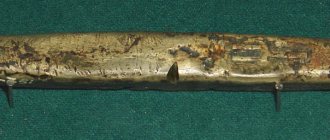The gold and foreign exchange reserves of this state occupy second place in the ranking of savings in different countries. At the beginning of 2021, Germany's gold reserves were estimated at 3,670 tons of pure 999 gold bullion. Such an impressive figure indicates serious economic power, which makes it possible to easily issue its own currency and support it with a gold standard. However, it is this impressive volume that causes the greatest number of doubts among precious metals market experts.
Professional analysts ask the question, where did Germany have a large gold reserve if this country was bled dry by the huge indemnities of the First and Second World Wars? The answer to this question lies on different levels. Some experts, not without reason, believe that the main source of the current “golden” wealth is the mysterious gold of the Third Reich. And in order to unravel this mystery, it is necessary to make a short historical excursion into the biography of the gold accumulations of this country, which was warlike in the past.
History of German gold and foreign exchange reserves. Curious Myths and Mysteries
1.After the end of World War I, the Weimar Republic already possessed an impressive reserve of physical gold, estimated at 455 tons. However, the indemnities paid and the economic crisis that broke out practically reduced these savings to zero. And then Hitler, who came to power, threw his remaining reserves into restoring the military-industrial complex. And by 1938, Germany had no more than 15 tons of metal currency in its vaults.
2. By the beginning of the Second World War, the Nazi leaders were faced with the task of quickly replenishing storage facilities with gold necessary to create weapons and support the domestic economy. The simplest solution was found - to plunder the conquered countries. And after the “reunification” with Austria, Germany received 78 tons of gold, and with the capture of Czechoslovakia - another 22 tons.
3. The merciless robbery of Jews even before the war brought at least 20 tons of precious metal into the German treasury. And then the Germans shamelessly appropriated the gold reserves of the captured countries - 198 tons in Belgium, 171 tons in Holland, about 22 tons in Italy. But there was a problem with France - the French government managed to withdraw its gold reserves by sea to the USA.
The main buyer of stolen gold was neutral Switzerland, which acquired more than 360 tons of pure gold from the Nazis during the Second World War. To determine the fate of looted European gold, the London Conference was organized immediately after the war. At this expert meeting, a fantastic figure for those times was named. It turned out that from 1939 to 1945, the turnover of physical gold in Nazi Germany amounted to 808 tons.
In 1945, the remainder of the national gold reserve of 111 tons was taken by a special SS team to the Bavarian Alps. The hidden treasure was later found by Allied forces. The question of where about 700 tons of gold went remains open. Most likely, this volume was transferred through Swiss banks to the countries of South America, where many Nazi bosses subsequently settled.
In 1951, the so-called economic miracle took place in restored Germany - the economy grew by leaps and bounds, and the country began to form a national gold and foreign exchange reserve. And by 1968, gold bullion reserves reached a historical maximum of 4,000 tons! It is still unclear where a country that survived such a terrible war got the funds to acquire such impressive volumes of precious metal. After all, there were no large gold deposits on the territory of Germany. And here again a version emerges with well-hidden Nazi gold, which was never found by either Soviet or allied troops.
Complicated story
As you know, the American economy (and what can I say, the world economy) is based on virtual (electronic) money. Every day, thousands of brokers on stock exchanges sell and buy stocks, currencies and precious metals. And if with the last two cases the situation is quite transparent, then with bonds the matter is murky. People buy and resell debt, and according to some estimates, there is now twenty times the world's GDP! What if one day you have to pay for these obligations?
According to this principle, a huge foreign debt of the United States appeared, because the printing press does not belong to the state. For social reforms, the government has to borrow money from a group of private banks. Agree that banks will lend money to someone who will never pay it back for the time being. At least this cannot continue for long.
There is an opinion that there is no more gold in the United States Federal Reserve (and this is in the country where Germany's gold reserves are kept!). It was either pledged as debt or actively sold to keep the price of gold low. The first assumption is confirmed by another scandal of the recent past.
Where is Germany's gold reserves stored today?
This state initially distributed most of its gold savings to banks in developed countries - the USA, England and France. Starting in 2013, the country began actively returning its own physical gold from foreign storage facilities. The first request for the return of 300 tons was made to the US Federal system. The return process was quite difficult, since America generally does not like to part with other people's property. And only by 2021 did Germany receive the entire requested volume, which replenished the Frankfurt storage facilities.
It is worth noting that bars with other marks arrived from the USA, which were probably purchased by America urgently in order not to “lose face.” The fact that the United States uses at its discretion the gold reserves of various countries transferred for safekeeping is no longer subject to doubt.
It is difficult to answer the question of where Germany's gold reserves are located today. It is known that it is still distributed among the banks of the world's leading powers. According to official statistics, currently about 36% of German gold continues to be stored in a bank in New York, 12% in London vaults, and 2.7% in the Paris National Bank. According to the plans of German financiers, half of the gold reserves should return to the country by 2020.
How the scandal began
About a year ago, several members of the Bundestag “unexpectedly” found out where Germany’s gold reserves were kept, namely 45%. The word “unexpectedly” is put in quotation marks because the very idea that politicians occupying such high positions did not know about this until now causes not just surprise, but a grin. Most likely, this was a populist step aimed at increasing their own ratings.
There is another version: the situation had reached such a dead end that there was no point in remaining silent any longer. It seems that this version is correct.
In general, the Germans, of course, have something to worry about. Germany's gold reserves are 3,386 tons, the second largest in the world! In first place, naturally, is the United States of America, the presence of precious metal in its storage facilities has been called into question for some time now.
Reasons for the long emigration of German gold
Why Germany's gold reserves were kept in the United States for so long - political and historical analysts can answer this question. Most likely, the following reasons occur:
- from the very beginning, the precious metal was purchased on the exchanges of London and New York, and the prudent Germans did not want to incur significant costs for transportation and security. And it was easier and more profitable to sell gold in case of need in these countries;
- post-war West Germany saw America as the only powerful ally capable of preserving national wealth;
- The United States at that time was rightfully considered the place of the most active trade in precious metals, which could bring profit to countries that kept their gold and foreign exchange savings in American safes;
- storing gold on the territory of West Germany in close proximity to the group of Soviet troops in East Berlin was dangerous;
Today, the planned repatriation of Germany's gold reserves is linked to the ongoing global crisis in Western Europe. Prudent Germans quite rightly fear that in an unstable political and economic situation, the US dollar may lose its status as an international currency. This event will cause a financial collapse on all exchanges on the planet. During such a catastrophe, only gold can keep the country afloat, allowing it to issue its own currency or back up the banknotes in use.
Will this country be able to return its gold reserves to its own vaults? Leading German politicians and financiers are trying to answer this question today. In any case, judging by the rate of return, none of the “trusted persons” is in a hurry to part with other people’s wealth.
The fact that America supplied bars with other marks is a gross violation of the etiquette of the financial world, which Germany was forced to accept for political reasons. The worst outcome for the country could be the “return of gold” with American dollars, which, as we know, have not been backed up by the sacred magic of the “yellow devil” for a long time. So the second place occupied by German gold reserves can be considered very conditional.
Poor quality bars
Recently another story of the post-war years was made public. It turns out that after World War II, a batch of ingots of obviously low quality was delivered from the USA to England, of which the central banks of these powers were well aware. The documents found indicate that the gold did not meet the so-called London Quality Supply standard. Since the last delivery was intended for Germany as part of regular payments, this was kept silent. And the Germans, who at that moment had no time for disputes, accepted the “gold” without hesitation.
This is one famous case. It remains a mystery how many low-quality gold supplies there were in Germany and what is actually in Germany’s vaults now?
Another story from the recent past immediately comes to mind. The Chinese discovered that some banks around the world were storing counterfeit bars that were made of tungsten and plated with gold. One can only guess what was actually supplied to Germany. But let's return to London.
Concentration camp prisoners' gold
The first negotiations between the Nazis and American intelligence services took place in 1943 in Bern. Section VI of the SD Directorate "Ausland", headed by Walter Schellenberg, presented a report to Reichsführer SS Himmler on the secret meeting of Prince Max Egon von Hohenlohe with the head of the US OSS Allen Dulles. It is believed that the negotiations ended in nothing, but it is possible that it was then that the Nazis found channels through which they were later able to remove gold from Europe.
The situation worsened in 1944. In the fall, trains with stolen gold went from east to west. For example, in Budapest a train of 80 cars was formed. 38 carriages were filled with jewelry from concentration camp prisoners. In December, the train moved along the route Veszprém - Ferteboz - Vienna - Salzburg.
Until the end of March 1945, the train stood on the border with Austria, and then wandered around Austria until May 11, until it fell into the hands of the Americans in a tunnel near Salzburg. The lion's share of the loot went to the United States. Some things were returned to Hungary (for example, the crown of St. Stephen), but the Americans kept the bullion for themselves.
38 wagons with jewelry from concentration camp prisoners also “stuck” to the hands of the Americans. In 1948, General Mark Clark refused to return the cars, citing the fact that the origin of the gold could not be proven. A convenient position, especially considering that Hungary at that moment was under the influence of the Soviet Union. The further fate of the gold is unknown.
Disappeared trains
It wasn't just this train that disappeared in the mountains of Austria. Gold was exported here from the vaults of the Reichsbank, thousands of tons of gold and platinum, kilograms of diamonds from Belgium and the USSR.
On January 31, 1945, at the proposal of German Finance Minister Walter Funk, it was decided to evacuate the gold reserves of the Reichsbank. Train No. 277 with 24 wagons of gold left Berlin for Obersalzberg and... disappeared again. 120 tons of Mussolini's gold, 100 tons of gold from the Croatian dictator Pavelic, 50 tons of platinum from the Cossack SS Corps, and emeralds from the Slovak dictator Tiso were delivered to the railway stations near the resort of Bad Aussee. Near Lake Altsee, traces of three wagons of gold from Soviet Ukraine are lost. Near the town of Bad Aussee, traces of gold exported from Romania are lost. Also disappeared: a ton of gold chervonets of the Tatar SS legion “Idel-Ural”, diamonds of the Gauleiter of Upper Austria Aigruber and 200 kg of gold of the Estonian SS men. But it is known for certain that the Nazi Horst Fuldner took 400 million dollars to Argentina. And on August 17, 1945, $3 billion worth of gold was transported to Argentina on the submarine U-977. After the war, the Americans found only a fifth of the Reich's treasures.
When ends don't meet
In 2011, one of the largest private custodians of gold in the world was forced to go to court to determine who actually owned $850 million worth of the precious metal. This happened when several owners began to lay claim to the same bullion. The latter, in turn, was led to by the fact that during credit operations the gold was re-pledged several times, and now it is simply not possible to determine its real owner. And all this despite the fact that the precious metal in storage is not subject to such operations.











